

Narrative Writing: A Complete Guide for Teachers and Students
MASTERING THE CRAFT OF NARRATIVE WRITING
Narratives build on and encourage the development of the fundamentals of writing. They also require developing an additional skill set: the ability to tell a good yarn, and storytelling is as old as humanity.
We see and hear stories everywhere and daily, from having good gossip on the doorstep with a neighbor in the morning to the dramas that fill our screens in the evening.
Good narrative writing skills are hard-won by students even though it is an area of writing that most enjoy due to the creativity and freedom it offers.
Here we will explore some of the main elements of a good story: plot, setting, characters, conflict, climax, and resolution . And we will look too at how best we can help our students understand these elements, both in isolation and how they mesh together as a whole.

WHAT IS A NARRATIVE?

A narrative is a story that shares a sequence of events , characters, and themes. It expresses experiences, ideas, and perspectives that should aspire to engage and inspire an audience.
A narrative can spark emotion, encourage reflection, and convey meaning when done well.
Narratives are a popular genre for students and teachers as they allow the writer to share their imagination, creativity, skill, and understanding of nearly all elements of writing. We occasionally refer to a narrative as ‘creative writing’ or story writing.
The purpose of a narrative is simple, to tell the audience a story. It can be written to motivate, educate, or entertain and can be fact or fiction.
A COMPLETE UNIT ON TEACHING NARRATIVE WRITING

Teach your students to become skilled story writers with this HUGE NARRATIVE & CREATIVE STORY WRITING UNIT . Offering a COMPLETE SOLUTION to teaching students how to craft CREATIVE CHARACTERS, SUPERB SETTINGS, and PERFECT PLOTS .
Over 192 PAGES of materials, including:
TYPES OF NARRATIVE WRITING
There are many narrative writing genres and sub-genres such as these.
We have a complete guide to writing a personal narrative that differs from the traditional story-based narrative covered in this guide. It includes personal narrative writing prompts, resources, and examples and can be found here.

As we can see, narratives are an open-ended form of writing that allows you to showcase creativity in many directions. However, all narratives share a common set of features and structure known as “Story Elements”, which are briefly covered in this guide.
Don’t overlook the importance of understanding story elements and the value this adds to you as a writer who can dissect and create grand narratives. We also have an in-depth guide to understanding story elements here .
CHARACTERISTICS OF NARRATIVE WRITING
Narrative structure.
ORIENTATION (BEGINNING) Set the scene by introducing your characters, setting and time of the story. Establish your who, when and where in this part of your narrative
COMPLICATION AND EVENTS (MIDDLE) In this section activities and events involving your main characters are expanded upon. These events are written in a cohesive and fluent sequence.
RESOLUTION (ENDING) Your complication is resolved in this section. It does not have to be a happy outcome, however.
EXTRAS: Whilst orientation, complication and resolution are the agreed norms for a narrative, there are numerous examples of popular texts that did not explicitly follow this path exactly.
NARRATIVE FEATURES
LANGUAGE: Use descriptive and figurative language to paint images inside your audience’s minds as they read.
PERSPECTIVE Narratives can be written from any perspective but are most commonly written in first or third person.
DIALOGUE Narratives frequently switch from narrator to first-person dialogue. Always use speech marks when writing dialogue.
TENSE If you change tense, make it perfectly clear to your audience what is happening. Flashbacks might work well in your mind but make sure they translate to your audience.
THE PLOT MAP

This graphic is known as a plot map, and nearly all narratives fit this structure in one way or another, whether romance novels, science fiction or otherwise.
It is a simple tool that helps you understand and organise a story’s events. Think of it as a roadmap that outlines the journey of your characters and the events that unfold. It outlines the different stops along the way, such as the introduction, rising action, climax, falling action, and resolution, that help you to see how the story builds and develops.
Using a plot map, you can see how each event fits into the larger picture and how the different parts of the story work together to create meaning. It’s a great way to visualize and analyze a story.
Be sure to refer to a plot map when planning a story, as it has all the essential elements of a great story.
THE 5 KEY STORY ELEMENTS OF A GREAT NARRATIVE (6-MINUTE TUTORIAL VIDEO)
This video we created provides an excellent overview of these elements and demonstrates them in action in stories we all know and love.

HOW TO WRITE A NARRATIVE

Now that we understand the story elements and how they come together to form stories, it’s time to start planning and writing your narrative.
In many cases, the template and guide below will provide enough details on how to craft a great story. However, if you still need assistance with the fundamentals of writing, such as sentence structure, paragraphs and using correct grammar, we have some excellent guides on those here.
USE YOUR WRITING TIME EFFECTIVELY: Maximize your narrative writing sessions by spending approximately 20 per cent of your time planning and preparing. This ensures greater productivity during your writing time and keeps you focused and on task.
Use tools such as graphic organizers to logically sequence your narrative if you are not a confident story writer. If you are working with reluctant writers, try using narrative writing prompts to get their creative juices flowing.
Spend most of your writing hour on the task at hand, don’t get too side-tracked editing during this time and leave some time for editing. When editing a narrative, examine it for these three elements.
- Spelling and grammar ( Is it readable?)
- Story structure and continuity ( Does it make sense, and does it flow? )
- Character and plot analysis. (Are your characters engaging? Does your problem/resolution work? )
1. SETTING THE SCENE: THE WHERE AND THE WHEN

The story’s setting often answers two of the central questions in the story, namely, the where and the when. The answers to these two crucial questions will often be informed by the type of story the student is writing.
The story’s setting can be chosen to quickly orient the reader to the type of story they are reading. For example, a fictional narrative writing piece such as a horror story will often begin with a description of a haunted house on a hill or an abandoned asylum in the middle of the woods. If we start our story on a rocket ship hurtling through the cosmos on its space voyage to the Alpha Centauri star system, we can be reasonably sure that the story we are embarking on is a work of science fiction.
Such conventions are well-worn clichés true, but they can be helpful starting points for our novice novelists to make a start.
Having students choose an appropriate setting for the type of story they wish to write is an excellent exercise for our younger students. It leads naturally onto the next stage of story writing, which is creating suitable characters to populate this fictional world they have created. However, older or more advanced students may wish to play with the expectations of appropriate settings for their story. They may wish to do this for comic effect or in the interest of creating a more original story. For example, opening a story with a children’s birthday party does not usually set up the expectation of a horror story. Indeed, it may even lure the reader into a happy reverie as they remember their own happy birthday parties. This leaves them more vulnerable to the surprise element of the shocking action that lies ahead.
Once the students have chosen a setting for their story, they need to start writing. Little can be more terrifying to English students than the blank page and its bare whiteness stretching before them on the table like a merciless desert they must cross. Give them the kick-start they need by offering support through word banks or writing prompts. If the class is all writing a story based on the same theme, you may wish to compile a common word bank on the whiteboard as a prewriting activity. Write the central theme or genre in the middle of the board. Have students suggest words or phrases related to the theme and list them on the board.
You may wish to provide students with a copy of various writing prompts to get them started. While this may mean that many students’ stories will have the same beginning, they will most likely arrive at dramatically different endings via dramatically different routes.

A bargain is at the centre of the relationship between the writer and the reader. That bargain is that the reader promises to suspend their disbelief as long as the writer creates a consistent and convincing fictional reality. Creating a believable world for the fictional characters to inhabit requires the student to draw on convincing details. The best way of doing this is through writing that appeals to the senses. Have your student reflect deeply on the world that they are creating. What does it look like? Sound like? What does the food taste like there? How does it feel like to walk those imaginary streets, and what aromas beguile the nose as the main character winds their way through that conjured market?
Also, Consider the when; or the time period. Is it a future world where things are cleaner and more antiseptic? Or is it an overcrowded 16th-century London with human waste stinking up the streets? If students can create a multi-sensory installation in the reader’s mind, then they have done this part of their job well.
Popular Settings from Children’s Literature and Storytelling
- Fairytale Kingdom
- Magical Forest
- Village/town
- Underwater world
- Space/Alien planet
2. CASTING THE CHARACTERS: THE WHO
Now that your student has created a believable world, it is time to populate it with believable characters.
In short stories, these worlds mustn’t be overpopulated beyond what the student’s skill level can manage. Short stories usually only require one main character and a few secondary ones. Think of the short story more as a small-scale dramatic production in an intimate local theater than a Hollywood blockbuster on a grand scale. Too many characters will only confuse and become unwieldy with a canvas this size. Keep it simple!
Creating believable characters is often one of the most challenging aspects of narrative writing for students. Fortunately, we can do a few things to help students here. Sometimes it is helpful for students to model their characters on actual people they know. This can make things a little less daunting and taxing on the imagination. However, whether or not this is the case, writing brief background bios or descriptions of characters’ physical personality characteristics can be a beneficial prewriting activity. Students should give some in-depth consideration to the details of who their character is: How do they walk? What do they look like? Do they have any distinguishing features? A crooked nose? A limp? Bad breath? Small details such as these bring life and, therefore, believability to characters. Students can even cut pictures from magazines to put a face to their character and allow their imaginations to fill in the rest of the details.
Younger students will often dictate to the reader the nature of their characters. To improve their writing craft, students must know when to switch from story-telling mode to story-showing mode. This is particularly true when it comes to character. Encourage students to reveal their character’s personality through what they do rather than merely by lecturing the reader on the faults and virtues of the character’s personality. It might be a small relayed detail in the way they walk that reveals a core characteristic. For example, a character who walks with their head hanging low and shoulders hunched while avoiding eye contact has been revealed to be timid without the word once being mentioned. This is a much more artistic and well-crafted way of doing things and is less irritating for the reader. A character who sits down at the family dinner table immediately snatches up his fork and starts stuffing roast potatoes into his mouth before anyone else has even managed to sit down has revealed a tendency towards greed or gluttony.
Understanding Character Traits
Again, there is room here for some fun and profitable prewriting activities. Give students a list of character traits and have them describe a character doing something that reveals that trait without ever employing the word itself.
It is also essential to avoid adjective stuffing here. When looking at students’ early drafts, adjective stuffing is often apparent. To train the student out of this habit, choose an adjective and have the student rewrite the sentence to express this adjective through action rather than telling.
When writing a story, it is vital to consider the character’s traits and how they will impact the story’s events. For example, a character with a strong trait of determination may be more likely to overcome obstacles and persevere. In contrast, a character with a tendency towards laziness may struggle to achieve their goals. In short, character traits add realism, depth, and meaning to a story, making it more engaging and memorable for the reader.
Popular Character Traits in Children’s Stories
- Determination
- Imagination
- Perseverance
- Responsibility
We have an in-depth guide to creating great characters here , but most students should be fine to move on to planning their conflict and resolution.
3. NO PROBLEM? NO STORY! HOW CONFLICT DRIVES A NARRATIVE

This is often the area apprentice writers have the most difficulty with. Students must understand that without a problem or conflict, there is no story. The problem is the driving force of the action. Usually, in a short story, the problem will center around what the primary character wants to happen or, indeed, wants not to happen. It is the hurdle that must be overcome. It is in the struggle to overcome this hurdle that events happen.
Often when a student understands the need for a problem in a story, their completed work will still not be successful. This is because, often in life, problems remain unsolved. Hurdles are not always successfully overcome. Students pick up on this.
We often discuss problems with friends that will never be satisfactorily resolved one way or the other, and we accept this as a part of life. This is not usually the case with writing a story. Whether a character successfully overcomes his or her problem or is decidedly crushed in the process of trying is not as important as the fact that it will finally be resolved one way or the other.
A good practical exercise for students to get to grips with this is to provide copies of stories and have them identify the central problem or conflict in each through discussion. Familiar fables or fairy tales such as Three Little Pigs, The Boy Who Cried Wolf, Cinderella, etc., are great for this.
While it is true that stories often have more than one problem or that the hero or heroine is unsuccessful in their first attempt to solve a central problem, for beginning students and intermediate students, it is best to focus on a single problem, especially given the scope of story writing at this level. Over time students will develop their abilities to handle more complex plots and write accordingly.
Popular Conflicts found in Children’s Storytelling.
- Good vs evil
- Individual vs society
- Nature vs nurture
- Self vs others
- Man vs self
- Man vs nature
- Man vs technology
- Individual vs fate
- Self vs destiny
Conflict is the heart and soul of any good story. It’s what makes a story compelling and drives the plot forward. Without conflict, there is no story. Every great story has a struggle or a problem that needs to be solved, and that’s where conflict comes in. Conflict is what makes a story exciting and keeps the reader engaged. It creates tension and suspense and makes the reader care about the outcome.
Like in real life, conflict in a story is an opportunity for a character’s growth and transformation. It’s a chance for them to learn and evolve, making a story great. So next time stories are written in the classroom, remember that conflict is an essential ingredient, and without it, your story will lack the energy, excitement, and meaning that makes it truly memorable.
4. THE NARRATIVE CLIMAX: HOW THINGS COME TO A HEAD!

The climax of the story is the dramatic high point of the action. It is also when the struggles kicked off by the problem come to a head. The climax will ultimately decide whether the story will have a happy or tragic ending. In the climax, two opposing forces duke things out until the bitter (or sweet!) end. One force ultimately emerges triumphant. As the action builds throughout the story, suspense increases as the reader wonders which of these forces will win out. The climax is the release of this suspense.
Much of the success of the climax depends on how well the other elements of the story have been achieved. If the student has created a well-drawn and believable character that the reader can identify with and feel for, then the climax will be more powerful.
The nature of the problem is also essential as it determines what’s at stake in the climax. The problem must matter dearly to the main character if it matters at all to the reader.
Have students engage in discussions about their favorite movies and books. Have them think about the storyline and decide the most exciting parts. What was at stake at these moments? What happened in your body as you read or watched? Did you breathe faster? Or grip the cushion hard? Did your heart rate increase, or did you start to sweat? This is what a good climax does and what our students should strive to do in their stories.
The climax puts it all on the line and rolls the dice. Let the chips fall where the writer may…
Popular Climax themes in Children’s Stories
- A battle between good and evil
- The character’s bravery saves the day
- Character faces their fears and overcomes them
- The character solves a mystery or puzzle.
- The character stands up for what is right.
- Character reaches their goal or dream.
- The character learns a valuable lesson.
- The character makes a selfless sacrifice.
- The character makes a difficult decision.
- The character reunites with loved ones or finds true friendship.
5. RESOLUTION: TYING UP LOOSE ENDS
After the climactic action, a few questions will often remain unresolved for the reader, even if all the conflict has been resolved. The resolution is where those lingering questions will be answered. The resolution in a short story may only be a brief paragraph or two. But, in most cases, it will still be necessary to include an ending immediately after the climax can feel too abrupt and leave the reader feeling unfulfilled.
An easy way to explain resolution to students struggling to grasp the concept is to point to the traditional resolution of fairy tales, the “And they all lived happily ever after” ending. This weather forecast for the future allows the reader to take their leave. Have the student consider the emotions they want to leave the reader with when crafting their resolution.
While the action is usually complete by the end of the climax, it is in the resolution that if there is a twist to be found, it will appear – think of movies such as The Usual Suspects. Pulling this off convincingly usually requires considerable skill from a student writer. Still, it may well form a challenging extension exercise for those more gifted storytellers among your students.
Popular Resolutions in Children’s Stories
- Our hero achieves their goal
- The character learns a valuable lesson
- A character finds happiness or inner peace.
- The character reunites with loved ones.
- Character restores balance to the world.
- The character discovers their true identity.
- Character changes for the better.
- The character gains wisdom or understanding.
- Character makes amends with others.
- The character learns to appreciate what they have.
Once students have completed their story, they can edit for grammar, vocabulary choice, spelling, etc., but not before!
As mentioned, there is a craft to storytelling, as well as an art. When accurate grammar, perfect spelling, and immaculate sentence structures are pushed at the outset, they can cause storytelling paralysis. For this reason, it is essential that when we encourage the students to write a story, we give them license to make mechanical mistakes in their use of language that they can work on and fix later.
Good narrative writing is a very complex skill to develop and will take the student years to become competent. It challenges not only the student’s technical abilities with language but also her creative faculties. Writing frames, word banks, mind maps, and visual prompts can all give valuable support as students develop the wide-ranging and challenging skills required to produce a successful narrative writing piece. But, at the end of it all, as with any craft, practice and more practice is at the heart of the matter.
TIPS FOR WRITING A GREAT NARRATIVE
- Start your story with a clear purpose: If you can determine the theme or message you want to convey in your narrative before starting it will make the writing process so much simpler.
- Choose a compelling storyline and sell it through great characters, setting and plot: Consider a unique or interesting story that captures the reader’s attention, then build the world and characters around it.
- Develop vivid characters that are not all the same: Make your characters relatable and memorable by giving them distinct personalities and traits you can draw upon in the plot.
- Use descriptive language to hook your audience into your story: Use sensory language to paint vivid images and sequences in the reader’s mind.
- Show, don’t tell your audience: Use actions, thoughts, and dialogue to reveal character motivations and emotions through storytelling.
- Create a vivid setting that is clear to your audience before getting too far into the plot: Describe the time and place of your story to immerse the reader fully.
- Build tension: Refer to the story map earlier in this article and use conflict, obstacles, and suspense to keep the audience engaged and invested in your narrative.
- Use figurative language such as metaphors, similes, and other literary devices to add depth and meaning to your narrative.
- Edit, revise, and refine: Take the time to refine and polish your writing for clarity and impact.
- Stay true to your voice: Maintain your unique perspective and style in your writing to make it your own.
NARRATIVE WRITING EXAMPLES (Student Writing Samples)
Below are a collection of student writing samples of narratives. Click on the image to enlarge and explore them in greater detail. Please take a moment to read these creative stories in detail and the teacher and student guides which highlight some of the critical elements of narratives to consider before writing.
Please understand these student writing samples are not intended to be perfect examples for each age or grade level but a piece of writing for students and teachers to explore together to critically analyze to improve student writing skills and deepen their understanding of story writing.
We recommend reading the example either a year above or below, as well as the grade you are currently working with, to gain a broader appreciation of this text type.

NARRATIVE WRITING PROMPTS (Journal Prompts)
When students have a great journal prompt, it can help them focus on the task at hand, so be sure to view our vast collection of visual writing prompts for various text types here or use some of these.
- On a recent European trip, you find your travel group booked into the stunning and mysterious Castle Frankenfurter for a single night… As night falls, the massive castle of over one hundred rooms seems to creak and groan as a series of unexplained events begin to make you wonder who or what else is spending the evening with you. Write a narrative that tells the story of your evening.
- You are a famous adventurer who has discovered new lands; keep a travel log over a period of time in which you encounter new and exciting adventures and challenges to overcome. Ensure your travel journal tells a story and has a definite introduction, conflict and resolution.
- You create an incredible piece of technology that has the capacity to change the world. As you sit back and marvel at your innovation and the endless possibilities ahead of you, it becomes apparent there are a few problems you didn’t really consider. You might not even be able to control them. Write a narrative in which you ride the highs and lows of your world-changing creation with a clear introduction, conflict and resolution.
- As the final door shuts on the Megamall, you realise you have done it… You and your best friend have managed to sneak into the largest shopping centre in town and have the entire place to yourselves until 7 am tomorrow. There is literally everything and anything a child would dream of entertaining themselves for the next 12 hours. What amazing adventures await you? What might go wrong? And how will you get out of there scot-free?
- A stranger walks into town… Whilst appearing similar to almost all those around you, you get a sense that this person is from another time, space or dimension… Are they friends or foes? What makes you sense something very strange is going on? Suddenly they stand up and walk toward you with purpose extending their hand… It’s almost as if they were reading your mind.
NARRATIVE WRITING VIDEO TUTORIAL

Teaching Resources
Use our resources and tools to improve your student’s writing skills through proven teaching strategies.
When teaching narrative writing, it is essential that you have a range of tools, strategies and resources at your disposal to ensure you get the most out of your writing time. You can find some examples below, which are free and paid premium resources you can use instantly without any preparation.
FREE Narrative Graphic Organizer

THE STORY TELLERS BUNDLE OF TEACHING RESOURCES

A MASSIVE COLLECTION of resources for narratives and story writing in the classroom covering all elements of crafting amazing stories. MONTHS WORTH OF WRITING LESSONS AND RESOURCES, including:
NARRATIVE WRITING CHECKLIST BUNDLE

OTHER GREAT ARTICLES ABOUT NARRATIVE WRITING

Narrative Writing for Kids: Essential Skills and Strategies

7 Great Narrative Lesson Plans Students and Teachers Love

Top 7 Narrative Writing Exercises for Students

How to Write a Scary Story
Free Printable Narrative Writing Worksheets for 7th Grade
Narrative Writing: Discover a collection of free printable worksheets for Grade 7 Reading & Writing teachers, focusing on enhancing students' narrative writing skills and creativity.

Explore Narrative Writing Worksheets by Grades
- kindergarten
Explore Other Subject Worksheets for grade 7
- Social studies
- Social emotional
- Foreign language
- Reading & Writing
Explore printable Narrative Writing worksheets for 7th Grade
Narrative Writing worksheets for Grade 7 are an essential tool for teachers to help their students develop strong reading and writing skills. These worksheets focus on various aspects of narrative writing, such as creating engaging characters, building a compelling plot, and using descriptive language. By incorporating these worksheets into their lesson plans, teachers can provide their students with the necessary practice to improve their writing abilities. Additionally, these worksheets can be used to teach students about different types of narratives, such as fiction and nonfiction writing. As students progress through their Grade 7 curriculum, they will become more confident in their reading and writing abilities, thanks to the support provided by these valuable resources.
Quizizz is an excellent platform that offers a variety of educational resources, including Narrative Writing worksheets for Grade 7. Teachers can use Quizizz to create engaging and interactive quizzes, which can be used alongside the worksheets to assess students' understanding of the material. Furthermore, Quizizz offers a wide range of other resources, such as Reading & Writing activities and Nonfiction Writing exercises, which can be used to supplement the Narrative Writing worksheets. By incorporating Quizizz into their teaching strategies, teachers can provide a well-rounded and comprehensive approach to developing their students' reading and writing skills. This platform not only helps students improve their abilities but also makes learning fun and enjoyable, ensuring that students remain engaged and motivated throughout their Grade 7 journey.
EL Education Curriculum
You are here.
- ELA 2019 G7:M1:U3:L7
Write a Narrative: Plan Narrative Techniques
In this lesson, daily learning targets, ongoing assessment.
- Technology and Multimedia
Supporting English Language Learners
Materials from previous lessons, new materials, closing & assessments, you are here:.
- ELA 2019 Grade 7
- ELA 2019 G7:M1
- ELA 2019 G7:M1:U3
Like what you see?
Order printed materials, teacher guides and more.
How to order
Help us improve!
Tell us how the curriculum is working in your classroom and send us corrections or suggestions for improving it.
Leave feedback
Focus Standards: These are the standards the instruction addresses.
- W.7.3b , W.7.3c
Supporting Standards: These are the standards that are incidental—no direct instruction in this lesson, but practice of these standards occurs as a result of addressing the focus standards.
- W.7.4 , W.7.5 , W.7.10 , SL.7.1
- I can write dialogue and description to change the pacing during action to engage the reader. ( W.7.3b , W.7.5 )
- I can use transitions to convey shifts from one time frame to another. ( W.7.3c , W.7.4 )
- Opening A: Entrance Ticket: Unit 3, Lesson 7 ( W.7.3b )
- Work Time B: Narrative Writing Plan graphic organizer ( W.7.3b , W.7.3c , W.7.4 , W.7.5 )
- Ensure there is a copy of Entrance Ticket: Unit 3, Lesson 7 at each student's workspace.
- Review the Narrative Writing checklist.
- Post the learning targets and applicable anchor charts (see Materials list).
Tech and Multimedia
- Work Time A: Ebook Nasreen's Secret School and projector to display it
Supports guided in part by CA ELD Standards 7.I.C.10, 7.I.C.12, 7.II.B.4, 7.II.C.6, and 7.II.C.7.
Important Points in the Lesson Itself
- To support ELLs, this lesson leads students through an activity in which they use an analysis of pacing, dialogue, and description in Nasreen’s Secret School to initiate and support the planning of pacing, dialogue, and description in their own narratives. This sequence of using a model to inform students’ own work is particularly useful to ELLs, who may need even clearer, more transparent examples of the narrative language and structures we intend them to emulate than native speakers because they may be less familiar with the words and conventions associated with the task.
- ELLs may find the process of using the Narrative Writing Plan graphic organizer to plan pacing—based on the insertion of description and dialogue—challenging because they may be unfamiliar with the words used to convey description and dialogue in English narrative. Therefore, additional supports such as the ones below may be useful when introducing the pacing section of the graphic organizer.
- description, dialogue, pacing, transitions (DS)
(A): Academic Vocabulary
(DS): Domain-Specific Vocabulary
- Domain-specific word wall (one for display; from Unit 1, Lesson 1, Work Time B)
- Academic word wall (one for display; from Unit 1, Lesson 1, Opening A)
- Nasreen's Secret School (ebook to display and read aloud) (from Unit 3, Lesson 4, Work Time B)
- Device with which to display the ebook
- Narrative Writing Plan graphic organizer (example for teacher reference) (from Unit 3, Lesson 4, Work Time B)
- Vocabulary log (one per student; from Unit 1, Lesson 2, Opening A)
- A Long Walk to Water (text; one per student; from Unit 1, Lesson 1, Work Time C)
- Notes and articles from independent research reading and other nonfiction texts from this module (begun in Unit 1)
- Narrative Writing Plan graphic organizer (one per student; from Unit 3, Lesson 4, Work Time B)
- Narrative Writing checklist (one per student; from Unit 3, Lesson 4, Closing and Assessment A)
- Homework: Create Illustrations (one per student; from Unit 3, Lesson 4, Homework A)
- Entrance Ticket: Unit 3, Lesson 7 (answers for teacher reference)
- Entrance Ticket: Unit 3, Lesson 7 (one per student)
- Online or print dictionaries (including ELL and home language dictionaries; one per small group of students)
- Narrative Transition Words and Phrases (one per student and one for display)
- Homework: Add Transition Words (one per student)
Each unit in the 6-8 Language Arts Curriculum has two standards-based assessments built in, one mid-unit assessment and one end of unit assessment. The module concludes with a performance task at the end of Unit 3 to synthesize students' understanding of what they accomplished through supported, standards-based writing.
Copyright © 2013-2024 by EL Education, New York, NY.
Get updates about our new K-5 curriculum as new materials and tools debut.
Help us improve our curriculum..
Tell us what’s going well, share your concerns and feedback.
Terms of use . To learn more about EL Education, visit eleducation.org
Writing Prompts for 7th Grade
Compassionate Eye Foundation/Robert Kent/Getty Images
- Lesson Plans
- Grading Students for Assessment
- Becoming A Teacher
- Assessments & Tests
- Elementary Education
- Special Education
- Homeschooling
:max_bytes(150000):strip_icc():format(webp)/squareheadshot-5b6da9aec9e77c0050a6e8a5.jpg)
By seventh grade, students should be refining the core writing skills of brainstorming , researching, outlining, drafting, and revising. In order to hone these skills, seventh-grade students need regular practice writing a variety of essay styles, including narrative, persuasive, expository , and creative essays. The following essay prompts offer age-appropriate starting points to help seventh graders flex their writing muscles.
Narrative Essay Writing Prompts
Narrative essays share a personal experience to tell a story, usually to make a point rather than merely to entertain. These narrative essay prompts encourage students to describe and reflect on a story that's meaningful to them.
- Embarrassing Pasts - As people get older, they are sometimes embarrassed by things they used to like, such as toys, television shows, or nicknames. Describe something that you used to enjoy that you now find embarrassing. Why is it embarrassing now?
- Bonds of Hardship - Sometimes difficulties draw families closer. Describe something that your family endured together that strengthened your relationships.
- There’s No Place Like Home - What makes your hometown special? Explain this special quality.
- New Kid in Town - Being new to a town or school can be challenging because you don’t know anyone, or exciting because no one knows you and your past. Describe a time when you were the new kid.
- Finders Keepers - Write about a time when you lost (or found) something of value. How did that experience affect your opinion of the saying, “Finders keepers; losers weepers?"
- Follow the Leader - Describe a time when you were in a leadership role. How did it make you feel? What did you learn from the experience?
- April Fools - Write about the best prank you’ve ever played on someone (or had played on you). What made it so clever or funny?
- Bon Appetit - Special meals can be powerful memory-makers. Write about a specific meal that stands out in your memory. What made it so unforgettable?
- Bon Voyage - Family trips and vacations also create lasting memories. Write an essay detailing your favorite family vacation memory.
- Batter Up - Write about a valuable lesson that you learned while playing your favorite sport.
- Best Friends Forever - Describe your friendship with your BFF and what makes it so important to you.
- The Real Me - What is one thing you wish your parents, teachers, or coaches really understood or knew about you?
- TV - Explain what makes your favorite television show so enjoyable or relatable to you.
Persuasive Essay Writing Prompts
Persuasive essays use facts and reasoning to convince the reader to embrace the writer’s opinion or take a course of action. These essay prompts empower seventh graders to write persuasively about an issue they genuinely care about.
- Outdated Laws - What is one law or family or school rule that you think needs to be changed? Convince lawmakers, your parents, or school leaders to make the change.
- Bad Ads - Advertising can have a powerful impact on consumers. What is a product that you’ve seen advertised that you don’t think should be? Explain why the media should quit showing these ads.
- Puppy Love - You want a pet, but your parents don’t think you need one. What would you say to change their minds?
- Lights, Camera - What is your favorite book of all time? Write an essay convincing a producer to make a movie about it.
- Snooze Button - Studies have shown that tweens and teens need more sleep. Write a proposal for a later school start time.
- Body Shop - Magazines can negatively impact their readers’ body image by using edited images of models. Convince a teen magazine publisher that they should not use heavily-edited model images in their publication.
- It Can’t Be Over - The network is canceling your favorite television show. Write a paper convincing the station that they’re making a mistake.
- Curfews - Some malls have policies forbidding kids under 18 to be at the mall without adult supervision during certain times. Do you think this is fair or unfair? Defend your position.
- Team Spirit - Should homeschooled students be allowed to play sports on public or private school teams? Why or why not?
- Smartphones - All of your friends have the latest smartphone, but you only have a “dumb phone.” Should your parents upgrade your phone, or are smartphones for middle school kids a bad idea?
- Bullies - Some dogs, such as pit bulls or Dobermans, are labeled “bully breeds.” Is this label deserved or undeserved?
- Money Can’t Buy You Love - People say that money can’t buy happiness, but some studies have shown that people with higher incomes may be happier . Do you think this is true? Why or why not?
- Ratings - There are age restrictions on movies and video games, ratings on television shows, and warning labels on music. Computers and smartphones offer parental controls. Do adults have too much control over what kids watch and listen to or do these restrictions serve a valuable purpose?
Expository Essay Writing Prompts
Expository essays describe a process or provide factual information. These prompts can serve as jumping-off points for the explanatory process.
- School’s in Session - Would you rather attend public school, private school, or be homeschooled. Explain the benefits of your choice.
- Admiration - Who do you admire from your life or history? Write an essay describing how their character or contributions to their community have earned your respect.
- Global Community - If you could live anywhere in the world, where would you live? Write about your dream hometown and why you want to live there.
- Peer Problems - Peer pressure and bullying can make life as a middle school student difficult. Describe a time you were pressured or bullied and how it affected you.
- Order Up - A friend wants to learn how to make your favorite food. Detail the process, step-by-step, so your friend can recreate the dish.
- Addictions - Many people are impacted by drug or alcohol addictions. Share facts about how the use of these substances negatively affects families or communities.
- Serve Others - Community service is a valuable experience. Describe a time you volunteered. What did you do and how did it make you feel?
- City or Country Mouse - Do you live in a big city or a small town? Explain why you do or don’t like living there.
- Aspirations - What do you want to be when you’re an adult? Explain why you’d choose that career or what you’ll do to prepare for it.
- Point in Time - Sometimes people bury time capsules so future generations can learn about the past. What would you include to give an accurate snapshot of life in the current time?
- Hobbyist - You’re friend wants to take up your favorite hobby. Explain it to him.
- SOS - A natural disaster has destroyed homes and businesses in a nearby city. Describe what you can do to help.
- Wonder Twin Power - Some superheroes can fly or become invisible. If you could have any superpower, what would it be and why?
Creative Essay Writing Prompts
Creative essays are fictional stories. They use plot, character, and dialog to engage and entertain the reader. These prompts will get the creative juices flowing.
- Fan Fic - Write a story about your favorite characters from a book, film, or television show.
- Cats vs. Dogs - You have two pets of different species. Write a story from their point of view about a day at home alone.
- Time Travel - You find a time machine in your backyard. What happens when you step inside?
- Dream State - Think about a time when you woke in the middle of a vivid dream. What would have happened if the dream hadn’t been interrupted?
- New Door - You’ve just discovered a door that you’ve never seen before. What happens when you walk through it?
- Secret Keeper - You find out your best friend has kept a secret from you. What is the secret and why didn’t your friend tell you?
- Fridge Fun - Write a story from the perspective of an item in your refrigerator.
- Desert Island - You’ve just discovered an uncharted island. What happens next?
- Fly on the Wall - You see two people talking excitedly, but you can’t hear what they’re saying. Write a story about what they might be saying.
- Special Delivery - You receive a battered package in the mail. Write a story about its journey from the sender to you.
- A Mile in My Shoes - You find a pair of shoes in the thrift store and put them on. Suddenly you find yourself transported into someone else’s life. Describe what happens.
- Mission to Mars - Imagine that you’re a pioneer to start a colony on Mars. Write about a typical day on your new planet.
- Snow Days - You find yourself snowed in for a week with your family. There is no electricity or phone service. What do you do for fun?
- Fun March Writing Prompts for Journaling
- 24 Journal Prompts for Creative Writing in the Elementary Classroom
- Writing Prompts for Elementary School Students
- Writing Prompts for 5th Grade
- February Writing Prompts
- November Writing and Journal Prompts
- The 2021-22 Common Application Essay Prompts
- Writing Prompt (Composition)
- Tips for an Admissions Essay on an Influential Person
- January Writing Prompts
- First Grade Writing Prompts
- Expository Essay Genre With Suggested Prompts
- October Writing Prompts
- Second Grade Writing Prompts
- December Writing Prompts
- Martin Luther King Jr. Writing Prompts
Narrative Writing Prompts for 7th Grade Students
Get ready to embark on an exciting journey as we delve into a wide range of narrative essay ideas that will prompt your 7th-grade students to reflect on their own experiences, explore their emotions, and exercise their storytelling skills. These story prompts , creative writing exercises , fictional prompts , and storytelling activities are designed to ignite their imagination and unlock their inner storyteller.
- Spark Your Students’ Creativity with Engaging Prompts
Encourage your students to dive deep into their thoughts, memories, and emotions with these narrative essay ideas . From personal experiences to friendships, fears, and aspirations, the prompts cover a diverse range of themes to captivate and inspire your young writers. They can choose from prompts that explore moments of pride, feeling left out, facing fears, and much more.
By engaging with these narrative essay prompts, your 7th-grade students will not only improve their writing skills but also develop important life skills such as empathy and self-reflection. These creative writing exercises provide a safe and supportive environment for students to express themselves, while enhancing their critical thinking and communication abilities.
So, why wait? Dive into these narrative essay ideas and watch your students’ creativity soar as they embark on a writing adventure filled with self-discovery and imagination.
Improve Writing Skills in a Supportive Environment with Middle School Narrative Prompts
Discover the incredible benefits of incorporating narrative writing prompts into your middle school curriculum as we explore how these prompts can foster a supportive environment for students to enhance their writing abilities and encourage self-expression. This collection of narrative writing prompts is designed to engage 7th-grade students in expressing their thoughts and feelings through writing, providing them with a safe space to develop their creativity, critical thinking, and communication skills.
By using these middle school narrative prompts, students can improve their writing skills while exploring a wide range of topics such as personal experiences, friendships, fears, and aspirations. These prompts encourage students to reflect on their emotions and memories, enabling them to develop their narrative storytelling abilities in a supportive environment. Through writing, students can dive deep into their thoughts and express themselves authentically.
- Creating a Supportive Environment for Writing Growth
Incorporating narrative writing prompts into the middle school curriculum creates a supportive environment where students feel encouraged to share their thoughts and ideas. Writing prompts provide clear guidelines and structure, allowing students to feel confident in their writing process. This supportive atmosphere promotes self-expression and helps students overcome any barriers or fears they may have about writing.
The narrative prompts encourage engagement and participation from all students, regardless of their skill level. Students can share their experiences and learn from one another, promoting a collaborative and inclusive environment. This not only enhances their writing abilities but also fosters empathy and understanding as they explore different perspectives and narratives.
In conclusion, narrative writing prompts offer numerous benefits for 7th-grade students in the middle school curriculum. By incorporating these prompts into your teaching, you can provide a supportive environment where students can enhance their writing skills, express themselves authentically, and develop important life skills. Encourage your students to explore their thoughts and feelings through writing, and witness the growth and creativity that emerges from their narrative storytelling.
- Unlock Creativity and Improve Writing Skills with Narrative Writing Prompts for 7th Grade Students
In conclusion, narrative writing prompts are a powerful tool that can unlock the creative potential of 7th-grade students while simultaneously enhancing their writing skills and fostering personal growth in a supportive educational environment. This collection of narrative writing prompts is designed to engage students in expressing their thoughts and feelings through writing, providing them with a platform to explore their emotions and memories.
These prompts cover a wide range of topics, including personal experiences, friendships, fears, and aspirations. Students are encouraged to reflect on their own experiences and choose prompts that resonate with them. They can write about moments of pride, feeling left out, facing fears, and much more, allowing them to delve deep into their thoughts and share their unique perspectives.
By utilizing narrative writing prompts, students not only improve their writing skills but also develop important life skills such as empathy and self-reflection. They learn to effectively communicate their ideas, thoughts, and emotions, fostering a greater understanding of themselves and others.
Within the context of a safe and supportive educational environment, these prompts provide students with the opportunity to freely express themselves without fear of judgment. This not only encourages creativity but also instills confidence in their writing abilities, enabling them to grow as writers and individuals.
- Source Links
- https://elementaryassessments.com/narrative-writing-prompts-for-middle-school/
- https://www.journalbuddies.com/prompts-by-grade/7th-grade-writing-ideas/
- https://www.teachersnotepad.com/narrative-writing-prompts-for-7th-grade/
Common Core State Standards Initiative
English Language Arts Standards » Writing » Grade 7
Standards in this strand:, text types and purposes:, production and distribution of writing:, research to build and present knowledge:, range of writing:.
- Key Design Consideration
- Students Who are College and Career Ready in Reading, Writing, Speaking, Listening, & Language
- How to Read the Standards
- College and Career Readiness Anchor Standards for Reading
- College and Career Readiness Anchor Standards for Writing
- College and Career Readiness Anchor Standards for Speaking and Listening
- College and Career Readiness Anchor Standards for Language
- Introduction for K-5
- Kindergarten
- Introduction for 6-12
- Grade 11-12
- Introduction
- Language Progressive Skills
- Measuring Text Complexity: Three Factors
- Range of Text Types for K-5
- Texts Illustrating the Complexity, Quality, & Range of Student Reading K-5
- Staying on Topic Within a Grade & Across Grades
- Range of Text Types for 6-12
- Texts Illustrating the Complexity, Quality, & Range of Student Reading 6-12
- English Language Arts Appendix A
- English Language Arts Appendix B
- English Language Arts Appendix C
7th grade personal narrative unit
All formats, resource types, all resource types.
- Rating Count
- Price (Ascending)
- Price (Descending)
- Most Recent
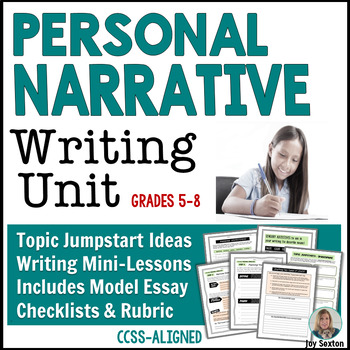
Narrative Writing - Personal Narrative Unit Grades 5 - 8


Middle School Personal Narrative Essay Writing Unit / Narrative Essay Assignment
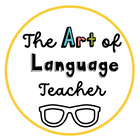
Sixth Grade Personal Narrative Small Moment Writing Unit

- Google Drive™ folder
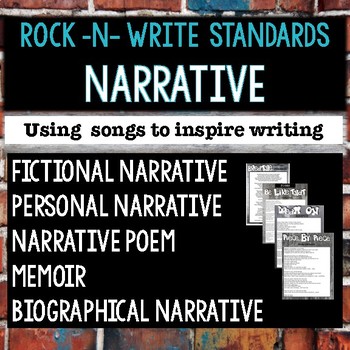
Fictional Narrative , Personal Narrative , and Memoir Writing with Song Lyrics

Common Core Personal Narrative Unit Plan & Assignments - 7th Grade Language Arts

Personal Narrative Example and Color Coding Activity- 6th, 7th , 8th Grade
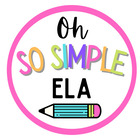
Personal Narrative Unit | Brainstorm Graphic Organizer Template Checklist Rubric

- Easel Activity
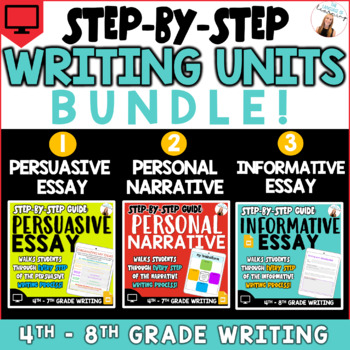
Writing Units BUNDLE! Personal Narrative , Persuasive, & Informative Essay Guides

Narrative Writing Unit : Personal Narratives | Printable and Digital

Middle School Writing Course: FULL YEAR ( Grades 6-9)

Personal Narrative Writing - Unit Two - Crafting Catchy Introductions

Personal Narrative Writing - Unit Three - Elaborating with Detailed Descriptions
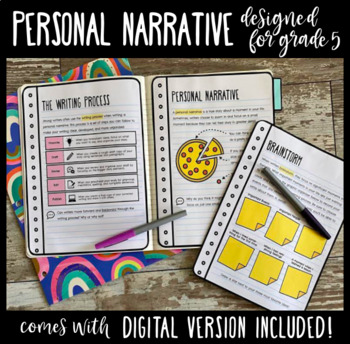
Personal Narrative Notebook and Mini-Lesson Unit — Digital Version Included!

Personal Narrative Writing - Unit One - Brainstorming and Planning
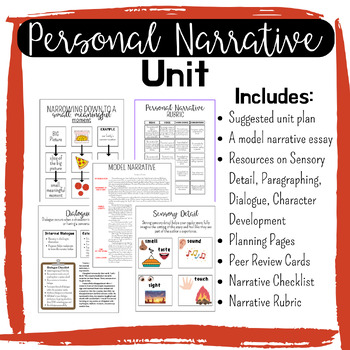
Personal Narrative Essay Unit

Personal Narrative Writing Unit

My Personal Hero Narrative Essay 10 Day Lesson Unit Middle School

Personal Narrative Lesson Plans/ Unit -Common Core!
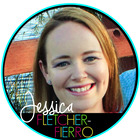
Personal Narrative Bingo

Personal Narrative Essay PowerPoint

Personal Narrative Writing - Unit Four - Creating Point of View & Voice
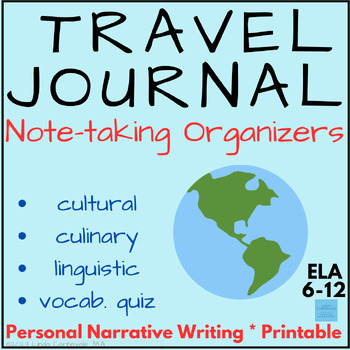
Personal Narrative Writing: Travel Journal + Paragraph Writing + Vocabulary Quiz

Personal Narrative Lessons, Activities, & Unit and Bulletin Board Bundle

Personal Narrative Writing - Unit Five - Developing a Meaningful Theme
- We're hiring
- Help & FAQ
- Privacy policy
- Student privacy
- Terms of service
- Tell us what you think
Unlocking Ideas: 100+ Prompts Tailored for the 7th-Grade Mind
By: Author Valerie Forgeard
Posted on August 17, 2023
Categories Writing
You’re about to dive into the world of writing prompts for 7th graders. You’ll discover their importance, explore various types, and learn how to choose the right one. This article aims to help you encourage creativity and boost critical thinking skills in your classroom or at home.
Key Takeaways
- Writing prompts ignite creativity and improve writing skills.
- Prompt categorization helps identify strengths and weaknesses.
- Challenging prompts can be rewarding.
- Understanding student interests is crucial for engaging 7th graders.
100 Writing Prompts for 7th Graders
Personal writing is like opening a window into your soul, allowing fresh insights to pour in and old doubts to flutter out. Every prompt is an invitation, a beckoning to delve deeper into your own psyche, experiences, and aspirations.
From your bravest moments to your most profound failures, these questions aim to guide you through a labyrinth of emotions, dreams, and memories.
Whether you’re a seasoned journal enthusiast or someone looking to start, this collection ensures that every day becomes an opportunity for introspection. Embrace the quest of understanding oneself, and let these prompts light your path.
- Write about a time you ventured out of your comfort zone.
- Reflect on your proudest achievement to date.
- If you could switch lives with someone, who would it be?
- Describe your ultimate leisure activity in detail.
- Recall a time fear gripped you.
- Sketch out your dream holiday scenario.
- Share a pivotal life lesson and its source.
- Narrate a day from your pet’s perspective.
- Envision an invention to better our world.
- List traits of a true friend.
- Reflect on a moment you swelled with pride.
- If you could reside anywhere, where would that be?
- Set a goal for this academic year.
- Talk about a moment of sheer disappointment.
- Dream up your superhero persona.
- Which possession holds great sentimental value?
- Plan your ideal weekend.
- Remember an instance when inspiration struck.
- Jot down things that tickle your funny bone.
- Offer a piece of advice for newcomers to your school.
- Paint a picture of your serene natural spot.
- Revisit a moment of profound gratitude.
- Describe your envisioned career path.
- Reflect on a holiday that warms your heart.
- Recall an experience with a hard-hitting lesson.
- Compliment yourself on a unique quality.
- Describe an unforgettable gesture of kindness towards you.
- Share feelings from a lonesome period.
- Define the markers of a commendable teacher.
- Take a trip down a cherished childhood memory lane.
- Introduce yourself to your role model.
- If you had a global platform for a day, what’s your message?
- Confront your greatest phobia.
- Chronicle a burst of creativity.
- Savor the memory of your most delectable meal.
- Celebrate what sets you apart from the crowd.
- Open up about facing and overcoming adversity.
- Rekindle one of life’s joyful milestones.
- If time travel were possible, where and when would you go?
- Describe your birthday bash of dreams.
- Recommend an unforgettable book.
- Unravel feelings from an anxious episode.
- Choose your dinner companion from any point in history.
- Revel in your favorite season’s charms.
- Salute your bravest act.
- Share three happiness sources.
- Reflect on a treasured family custom.
- If the zoo gates opened, which animal becomes your pet?
- Define the essence of friendship.
- If there’s one item in infinite supply, what’s your pick?
- Describe your ultimate weekend blueprint.
- Embark on your most thrilling adventure again.
- Spell out your most anticipated month.
- Recall a moment that tested your mettle.
- Who would attend your ideal birthday celebration?
- What qualities form a steadfast friend?
- Introduce your safe haven or retreat.
- If you were to compete in the Olympics, your sport is?
- Ponder upon a transformative experience.
- Which tune resonates with your soul?
- If any subject was available, what’s your elective?
- Share your strategy against looming fears.
- Detail your fantasy expedition.
- Reiterate a life-changing piece of advice.
- Unearth memories of a creative spree.
- Spotlight a goal for the upcoming year.
- Who stands as the beacon of heroism in your life?
- Set three targets for your current educational phase.
- Envision an unrestricted course for the next term.
- What activity makes weekends special for you?
- Recall a testing moment and its aftermath.
- Who’s the beacon of heroism in your world?
- Draft an action plan for an imminent objective.
- Explore an instance when motivation fueled you.
- If you could decode any subject next term, what would it be?
- Revisit an encounter that changed your perspective.
- If you could amplify a single trait, which would it be?
- What does an average day in your life look like?
- Share a moment when you stood up for something.
- Pen down your thoughts about personal growth.
- Recall an incident that evoked strong emotions.
- Describe a challenge and its valuable lessons.
- List hobbies that relax and rejuvenate you.
- Reflect on a time you surpassed your own expectations.
- Describe an act that left a lasting impact on you.
- Which creature comforts bring you the most joy?
- Share insights from an eye-opening book.
- Describe a random act of kindness you’ve recently witnessed.
- Chronicle a moment of sheer determination.
- If you were a novel character, who would you be?
- Reflect on an experience with a profound impact.
- Which fantasy realm would you reside in?
- Recall a time when a movie deeply moved you.
- If you authored a book, what’s its core message?
- Share your feelings on an unresolved personal challenge.
- Remember a moment that tested your patience.
- Explore feelings from a challenging transitional phase.
- Share an unexpected source of inspiration.
- Describe a ritual that centers and grounds you.
- Reflect on a time you stepped up as a leader.
Understanding the Importance of Writing Prompts

It’s vital for 7th graders to understand that writing prompts aren’t just school tasks, they’re tools to ignite their creativity and improve their writing skills. Prompt categorization helps you identify your strengths and weaknesses in different areas of writing. For instance, are you better at descriptive or narrative pieces? Use these prompts as a pathway to discover your unique voice.
Prompt diversity is also crucial. By responding to various types of prompts – from persuasive essays about current events to creative stories about imaginary worlds – you’ll become a more versatile writer. Don’t shy away from challenging ones; they can sometimes be the most rewarding!
Exploring Different Types of Writing Prompts

Let’s delve into the various kinds of assignments they’ll encounter. The key to prompt variety is understanding its role in student engagement.
You see, diverse prompts can cater to different learning styles and interests, making writing tasks more appealing.
Consider narrative prompts that encourage students to fabricate a story or share personal experiences. These stimulate creativity and self-expression.
Descriptive prompts, on the other hand, refine sensory observation skills as students paint vivid images with words.
Compare-contrast prompts foster critical thinking by analyzing similarities and differences between subjects.
Lastly, persuasive prompts develop argumentation skills as students defend their standpoints.
Tips to Choose the Right Writing Prompt

You’re about to dive into the art of choosing the right writing prompt, and it’s crucial you understand three key factors: student interests, difficulty level, and learning outcome.
It’s not enough to pick a prompt at random; you’ve got to hone in on what your students are passionate about to truly engage them.
Balancing their interests with an appropriate challenge and clear learning goals will make all the difference in their educational journey.
Understanding Student Interests
Understanding your students’ interests can significantly enhance your ability to create engaging writing prompts. It’s essential to consider student hobbies and extracurricular activities while crafting these prompts. This step not only fosters a connection between you and your pupils, but it also makes the learning process more enjoyable for them.
Here are some ways to explore their interests:
- Conduct surveys or questionnaires
- Keep an eye out for what they get excited about in class
- Engage with parents or caregivers about student hobbies outside school
- Observe their participation in extracurricular activities
Difficulty Level Consideration
It’s equally important to take into account the difficulty level of the tasks you’re assigning. You must strike a balance with prompt complexity to encourage student adaptability, not frustration. Too simple, and they’re bored; too hard, and they may give up.
Consider their academic abilities: Are they struggling or excelling? This requires adjusting your expectations and prompts accordingly. Engage them with challenges that stretch their capabilities but remain within reach.
Also, diversify task types — mix easier tasks with complex ones. This approach fosters resilience as students navigate different levels of challenge while boosting their confidence when they complete trickier assignments successfully.
Prompt’s Learning Outcome
Right on the heels of considering the difficulty level, you’re now ready to tackle ‘Prompt’s Learning Outcome.’
Understanding the outcome is paramount in prompt evaluation and curriculum integration. So, how can you ensure that your writing prompts are pedagogically effective?
- Start by aligning them with specific learning objectives.
- Next, consider how they fit into wider units or themes in your curriculum.
- Evaluate whether they encourage critical thinking and creativity.
- Lastly, think about their potential for engaging students and sparking interest.
Encouraging Creativity in 7th Graders

You’re about to explore three essential elements that can ignite the spark of creativity in your 7th graders: boosting creative thinking, innovative writing exercises, and nurturing artistic expression.
Each component is designed not only to enhance their academic skills but also to unleash their imaginative power.
Boosting Creative Thinking
Boosting creative thinking is often achieved through engaging in various forms of art, such as painting and music. But let’s not forget about writing too! You can overcome creativity barriers by using unconventional prompts.
Here are a few tips to help you:
- Break the norm: Use prompts that challenge traditional thinking. This could be an unusual scenario or a different perspective.
- Embrace randomness: Let unpredictability fuel your imagination. A random word or image can spark unique ideas.
- Think visually: Drawings or photos can serve as great prompts too, stimulating your visual intelligence.
- Be open to failures: Don’t fear making mistakes; they’re part of the creative process.
Innovative Writing Exercises
Let’s dive into some innovative exercises that’ll surely ignite your creative writing skills. Experiment with prompt variations and storytelling techniques to stretch your imagination.
For instance, try altering a well-known fairy tale by changing its setting or ending. This engages your creativity and helps you explore different narrative possibilities.
Another exercise is to use an object in your room as the central element of a story. Describe it vividly, give it a backstory, make it the hero or villain – there’re no limits!
Also consider retelling an event from multiple perspectives. It can be any historical event or even something mundane like making breakfast.
These exercises aren’t just fun but also great training in perspective-switching, character development, and plot creation. Give it a shot!
Nurturing Artistic Expression
Nurturing artistic expression isn’t only about mastering technical skills. It’s also about exploring one’s emotions and experiences in a creative way. As you facilitate your 7th grader’s artistic development, consider employing different expression techniques that will help them convey their thoughts and feelings effectively.
Here are some strategies to guide you:
- Encourage open-ended creativity: Don’t limit them to traditional forms of art.
- Provide an environment that fosters imagination: Surround them with inspiring materials and resources.
- Teach them how to use various tools: Brushes, pens, clay – the choices are endless.
- Promote emotional intelligence: Help them understand their feelings and translate those into art.
Writing Prompts to Boost Critical Thinking Skills

Encouraging critical thinking skills in 7th graders can be achieved through well-crafted writing prompts. Promoting empathy and digital literacy is a great way to do this.
Begin by presenting situations that require students to step into someone else’s shoes. Ask them how they’d feel, react, or handle those circumstances. This will not only stimulate their imagination but also foster understanding and compassion.
Incorporating digital literacy is equally important. You can assign tasks where they’ll need to evaluate the credibility of online sources or identify fake news. As they navigate these challenges, they’re honing their ability to discern truth from falsehood—an essential skill for the 21st century.
Narrative Writing Prompts for 7th Graders

You’re about to embark on a journey through narrative writing prompts specifically designed for 7th graders.
We’ll delve into the exploration of personal experiences, create imaginative scenarios, and reflect deeply through journal entries.
Get ready, as this adventure will not only hone your writing skills but also give you a chance to introspect and voice your thoughts in an engaging way.
Exploring Personal Experiences
Think about a time when you’ve faced a tough decision and what you learned from that experience. Exploring personal experiences can be an insightful journey into your own personal growth documentation, often revealing unseen perspectives.
When writing about personal experiences, consider these elements:
- Describe the situation in detail
- Identify the choices you had available
- Explain why it was a challenging choice
- Share what you learned from this experience
Writing about your own life isn’t just engaging for others to read, it’s also enlightening for yourself. It allows exploration of unseen perspectives and provides invaluable documentation of your personal growth.
Imaginative Scenario Prompts
Let’s dive into imaginative scenario prompts. They’re a fantastic way to spark creativity and broaden your horizons.
Picture this: you’re exploring alien encounters on a distant planet. How do you communicate? What does their society look like? These prompts push you to think outside the box and concoct wildly inventive narratives.
Now, let’s take a deep breath and plunge into underwater adventures. You’re swimming among vibrant coral reefs, encountering mysterious sea creatures. How do you navigate this new environment? What undiscovered species might lurk in the depths?
These scenarios aren’t just fun; they enhance critical thinking and writing skills. So next time you need inspiration, remember these unique scenarios. They’ll certainly stretch your imagination!
Reflective Journal Entries
Reflective journal entries can be quite enlightening. They’re an excellent tool for processing your thoughts and emotions. As a 7th grader, these can help you understand your emotional intelligence and navigate peer interactions better.
Consider the following prompts for your reflective journal entries:
- Reflect on a recent situation where you effectively managed your emotions.
- Narrate an incident involving a peer interaction that led to personal growth.
- Discuss how understanding others’ emotions has improved your relationships.
- Ponder over the role of empathy in enhancing emotional intelligence.
Writing about these will not only refine your writing skills but also boost self-awareness. So, grab a pen and start exploring yourself through words! Remember, it’s not just about recording events but recognizing feelings too.
Persuasive Writing Prompts for 7th Graders

You’ll find these persuasive writing prompts for 7th graders engaging and challenging. They are specially designed to have cultural relevance, making them more relatable and interesting for your students. For instance, one prompt could be debating the significance of celebrating diverse cultures in schools.
Moreover, incorporating humor into these prompts can make the learning process more enjoyable. You can ask your students to write a persuasive essay on why their favorite comedian should be considered a national treasure. This task will surely spark their interest and creativity.
Using these tactics not only enhances their critical thinking but also improves their ability to communicate effectively with others. It’s an excellent way to prepare them for real-world situations while keeping things fun and engaging!
Expository Writing Prompts for 7th Graders

Switching gears, expository tasks encourage your 7th grade students to investigate an idea, evaluate evidence, and present a clear point of view on the subject. Here’s where prompt selection strategies come into play. Selecting the right expository writing prompts can trigger their imagination and analytical skills.
Expository writing benefits are plenty:
- It enhances critical thinking.
- Boosts research skills.
- Improves clarity in communication.
- Increases knowledge on various topics.
You’ll find that it’s not just about improving their writing but also enriching their understanding of the world around them. So don’t hesitate to challenge them with diverse topics from technology to social issues. Remember, the goal is to make learning enjoyable and engaging while fostering intellectual growth.
Dealing With Writer’s Block

When tackling writer’s block, it’s important that you don’t let it intimidate you; instead, view it as a challenge to overcome. Consider this block overcoming strategy: seek inspiration from different sources and ignite your creativity. Maybe read a book or watch a movie that excites you. Take a walk in nature or listen to some music. You’d be surprised how these little things can spark your creative ignition.
How to Use Writing Prompts Effectively

Utilizing thought-provoking questions effectively can significantly aid in overcoming writer’s block and reigniting your creativity. To make the most of writing prompts, consider prompt personalization. Tailor each prompt to resonate with your interests or experiences.
Here are some tips on how to use writing prompts effectively:
- Personalize the scenario: Change the characters or setting to something more relatable.
- Use it as a jumping-off point: Let the prompt inspire you, but don’t feel limited by it.
- Add a twist: Modify the prompt to add an unexpected element that sparks your creativity.
- Set a timer: This can increase your writing motivation by creating a sense of urgency.
The Role of Feedback in Writing

It’s critical to understand the role of feedback in the writing process, as it offers a fresh perspective and can help hone one’s skills. Peer evaluation plays a significant part here. It allows you to receive reactions from someone who is on an equal footing with you and understands your position.
Feedback interpretation is another crucial aspect. You shouldn’t take criticism personally, instead see it as an opportunity for growth. Understand that each piece of advice given is meant to improve your writing abilities.
Example Writing Prompts and Responses

You’re going to find examples of prompts and responses incredibly useful for understanding the concept better. When it comes to prompt selection, it’s crucial to choose ones that will spark student motivation and push their thinking boundaries. Remember, you want your students not only to write but also to enjoy the process.
Here are a few example prompts:
- Write about a time when you had to make a tough decision.
- Describe a place that makes you feel happy.
- Imagine what life would be like if we could live on another planet.
- Craft an argument for or against school uniforms.
The aim is not just completion, but engagement. So, always consider students’ interests and aspirations when selecting prompts. This approach ensures they stay motivated throughout their writing journey.
The Benefits of Regular Writing Practice

After exploring various writing prompts and seeing how they can be tackled, let’s now dive into the benefits of regular writing practice.
As a 7th grader, you’re likely encountering more complex language tasks. Regular writing doesn’t just improve your ability to craft engaging stories or persuasive arguments; it also contributes significantly to your language development and vocabulary enhancement.
By consistently practicing, you’ll naturally expand your vocabulary as you strive to express yourself accurately and eloquently. You’re not just jotting down words—you’re learning how they interact, how they convey nuanced meanings, and how best to use them in different contexts.
So keep sharpening that pen (or keyboard!). The benefits are manifold: better academic performance, improved communication skills, even enhanced critical thinking.
Embrace the journey!
So, you’re all set to boost your 7th grader’s writing skills. Remember, the perfect prompt can ignite their creativity and critical thinking. Use them effectively, give constructive feedback, and encourage regular practice.
Dive into this exciting world of words together and watch them grow as confident, articulate writers!
All About Worksheets
See more Lesson Answer
7th Grade Prompts For Writing
7th worksheets essay prompts prompt journalbuddies graders tagalog writer desalas Optional enrichment activities Second grade writing prompts for great outcomes!
14 Best Images of Worksheets 4th Grade Narrative Writing - Narrative
Writing 7th grade prompts list essay creative pdf informative language arts kids timvandevall setting start write narrative 7th grade prompts writing journal graders journalbuddies topics school english opinion good middle students kids choose board Free printable writing prompts for kids, language arts pdf
Writing grade 7th prompts essay topics worksheets example argumentative research persuasive narrative essays paper thatsnotus worksheeto via printable english
12 grade writing prompts expositoryGrade 7th essay prompts writing persuasive expository prompt informative if were met ws group vocabulary help 65 creative and fun 7th grade writing prompts7th grade prompts writing students journalbuddies toughest focused challenges keeping teacher ll while during face time.
Writing grade prompts 6th pdf kids language arts 4th printable list 2nd printables 3rd 7th timvandevall14 best images of worksheets 4th grade narrative writing 14 best images of 7th grade writing worksheets7th grade writing prompts pdf.

Passages graders nonfiction comprehension summarizing 9th prompts desalas inference
Writing prompts for 2nd grade printable free printable 7th — db-excel.com7th grade argumentative writing prompts. 5th grade argumentative essay 7th grade writing prompts: 32 new ideas • journalbuddies.comGrade 7 printable prompts.
Prompts journalbuddies moby egusdPrompts spelling 7th prompts kidsnclicksEssay examples writing argumentative grade 7th paragraph prompts persuasive opinion essays 9th narrative sample kids school good 5th review students.

Writing prompts and ideas for 7th grade writers
Writing grade narrative 7th prompts staar worksheets 4th worksheeto viaEssay writing prompts 7th grade .

Free Printable Writing Prompts for Kids, Language Arts PDF

Essay Writing Prompts 7th Grade - 30 Writing Prompt Ideas for 7th Grade

Grade 7 Printable Prompts

14 Best Images of 7th Grade Writing Worksheets - 7th Grade Printable

Writing Prompts and Ideas for 7th Grade Writers

65 creative and fun 7th grade writing prompts - Kids n Clicks

7th Grade Writing Prompts: 32 New Ideas • JournalBuddies.com

7th grade argumentative writing prompts. 5th Grade Argumentative Essay
YOU MIGHT ALSO LIKE:
- Animal Writing
- 6th Grade Transition Words List
- Virginia Math Sol Grade 7
- Asl Letters Printable
- 6th Grade Sight Word List
- 7th Grade Math Sheets
- Addition Crossword Puzzle
- Baseball Math
- Addition And Subtraction Grade 2

IMAGES
VIDEO
COMMENTS
Step 2: Study the Structure of a Story. Now that students have a good library of their own personal stories pulled into short-term memory, shift your focus to a more formal study of what a story looks like. Use a diagram to show students a typical story arc like the one below.
By implementing narrative writing into your curriculum, you give your students an outlet to experiment with in a safe and structured environment. Below, you will find a list of narrative writing prompts to help your 7th graders let out some of their thoughts and get them writing about something that matters to them.
A narrative can spark emotion, encourage reflection, and convey meaning when done well. Narratives are a popular genre for students and teachers as they allow the writer to share their imagination, creativity, skill, and understanding of nearly all elements of writing. We occasionally refer to a narrative as 'creative writing' or story writing.
Narrative Writing Rubric for 7th grade. Worksheet. What's Your Story? Doing the Impossible. Worksheet. 1. Browse Printable 7th Grade Narrative Writing Worksheets. Award winning educational materials designed to help kids succeed. Start for free now!
Narrative Writing Teaching Resources for 7th Grade. Teach narrative writing this school year with writing prompts, printable worksheets, storyboards and story maps and more teaching resources created by...
Narrative Writing worksheets for Grade 7 are an essential tool for teachers to help their students develop strong reading and writing skills. These worksheets focus on various aspects of narrative writing, such as creating engaging characters, building a compelling plot, and using descriptive language. By incorporating these worksheets into ...
W.7.3a - Work Time C: Students use the model narrative to plan the character and setting (s) of their own narratives about a Lost Child of Sudan. W.7.5 - Closing and Assessment A: Students share their plans with a partner to develop and strengthen their writing with peer support. The Think-Pair-Share protocol is used in this lesson.
Use this standards-based Narrative Writing Rubric for 7th grade to assess your students' narrative writing skills! This helpful rubric covers the major standards in seventh-grade narrative writing, including organization, technique, transitions, style, and conclusion.
On-demand prompts do NOT go into the grade book, but rather serve as a baseline (1st prompt) and as a measure of growth (2nd prompt). Data gathered from the baseline prompt is used to direct our classroom instruction. Unit Documents/Activities: Narrative Writing Checklist for 7th Grade; Test Drive Scene "Other" Assessment; Setting Exploration ...
Narrative Writing Self-Assessment Checklist Grade 7 I write narratives to develop real or imagined experiences or events using effective technique, relevant descriptive details, and well-structured event sequences. 3 Meets 2 Approaching 1 Not Yet Introduction (W.7.3a) I wrote a beginning that engages and orients readers by
New skills are introduced in the following: W.7.3b - Work Time A: Students learn about how description and dialogue can impact pacing. W.7.3b - Work Time B: Students apply their learning from the mini lesson to plan the pacing, dialogue, and description of their narrative. W.7.3c - Closing and Assessment A: Students review and use ...
Narrative writing can go in two big directions for our writers- personal & fictional. Within these two are narrative writing elements that you'll want to showcase to your students. I like to focus on dialogue, focusing on small moments and experiences, using sensory details, using their imagination, and providing a clear ending. Presenting ...
Writing Prompts for 7th Grade. By seventh grade, students should be refining the core writing skills of brainstorming, researching, outlining, drafting, and revising. In order to hone these skills, seventh-grade students need regular practice writing a variety of essay styles, including narrative, persuasive, expository, and creative essays.
Developed for Empowering Education, Inc. by Educational Performance Consulting, LLC. 2 7th Grade English/Language Arts Narrative Writing Rubric - (continued) W.7.3 Write narratives to develop real or imagined experiences or events using effective technique, relevant descriptive details, and well-structured event sequences.
Arrange your students in a circle. The teacher joins the circle. Start the round-robin by reading aloud one of the Narrative Sentence Starter Cards. Moving in a clockwise direction, ask the next person to continue the story. The teacher finishes off the story when it returns to the starting point.
This collection of narrative writing prompts is designed to engage 7th-grade students in expressing their thoughts and feelings through writing, providing them with a safe space to develop their creativity, critical thinking, and communication skills. By using these middle school narrative prompts, students can improve their writing skills ...
Persuasive Writing Unit of Study February (15 days) Formative and Summative Assessment. Writing Workshop. E - Write routinely over extended time frames (time for research, reflection, and revision) and shorter time frames (a single sitting or a day or two) for a range of specific tasks, purposes, and audiences.
CCSS.ELA-Literacy.W.7.3.a. Engage and orient the reader by establishing a context and point of view and introducing a narrator and/or characters; organize an event sequence that unfolds naturally and logically. CCSS.ELA-Literacy.W.7.3.b. Use narrative techniques, such as dialogue, pacing, and description, to develop experiences, events, and/or ...
7th -12th grade Narrative Writing: This "print and teach", standards-aligned unit contains 4 engaging lessons that will walk your students through the process of writing both fictional and personal narratives. This unit uses songs from Kelly Clarkson, Aerosmith, 3 Doors Down and Anna Nalick as motivators and models for the writing assignments.
The Incredible Power of Words. One of the best ways to help your 7th graders through this challenging transitional period is to show them how writing can serve as a safe outlet for all of their feelings and ideas. (Yes, writing prompts for 7th grade writers can and will help, too!) When students journal, they have the freedom to fully explore ...
Seventh Grade Narrative Writing Sample 4. Seventh Grade Summary Sample 1. Seventh Grade Summary Sample 2. Seventh Grade Summary Sample 3. Seventh Grade Summary Sample 4. Seventh Grade Argumentative Essay Sample 3. Seventh Grade Argumentative Essay Sample 4.
100 Writing Prompts for 7th Graders. Personal writing is like opening a window into your soul, allowing fresh insights to pour in and old doubts to flutter out. Every prompt is an invitation, a beckoning to delve deeper into your own psyche, experiences, and aspirations. From your bravest moments to your most profound failures, these questions ...
My Most Memorable Day. Worksheet. Narrative Writing Rubric for 7th grade. Worksheet. 1. Browse 7th Grade Narrative Writing Educational Resources. Award winning educational materials designed to help kids succeed. Start for free now!
14 Best Images of Worksheets 4th Grade Narrative Writing - Narrative. Writing 7th grade prompts list essay creative pdf informative language arts kids timvandevall setting start write narrative 7th grade prompts writing journal graders journalbuddies topics school english opinion good middle students kids choose board Free printable writing ...